New Boston Historical Society
New Boston, New Hampshire
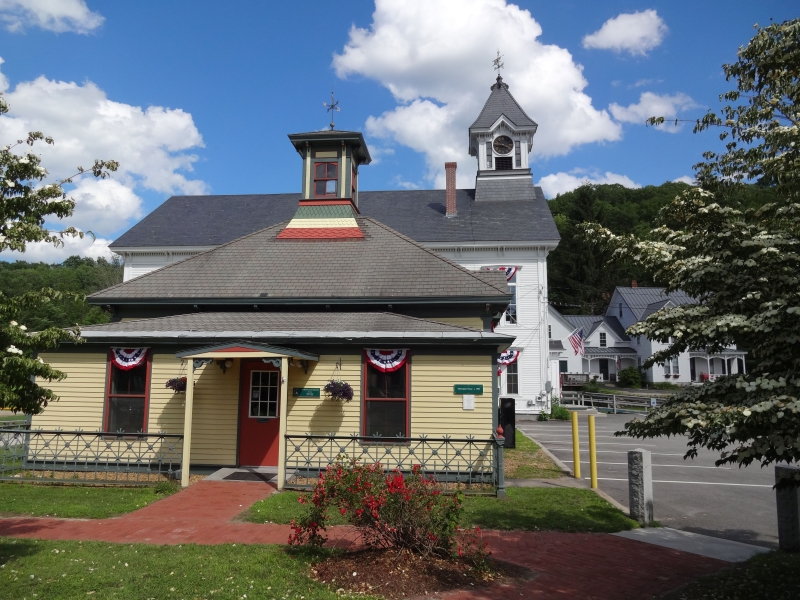
The Old Engine House in front of the New Boston Town Hall in 2013.
The Old Engine House
Built after the Fire of 1887, the Old Engine House was New Boston's firehouse for almost a century. It subsequently served as the Town Clerk's office and the Historical Society museum, and it is now the home of the Recreation Department. Let's explore the history of the Old Engine House, its glass-windowed cupola, its colorful woodwork, and its iron fence.
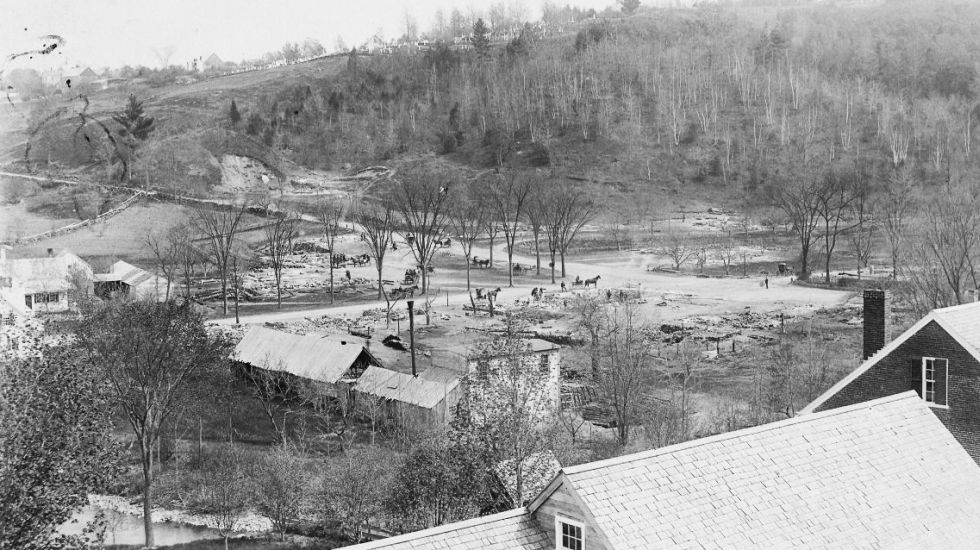
New Boston village after the Fire of 1887, which burned the previous firehouse
Wason's workshop survived the fire, but the general store nearby did not. Only a day before the photograph was taken, in that empty space above Wason's smokestack, there stood a Town Hall, a Baptist Church, and the original firehouse. To the right, across Meetinghouse Hill Road, there were a village school and a Presbyterian chapel, which also burned. The Historical Society has very few photographs of the village before the fire, and these show what the Town Hall, churches, school, and general store looked like. Unfortunately, the first firehouse is not visible in any photos of New Boston before 1887.
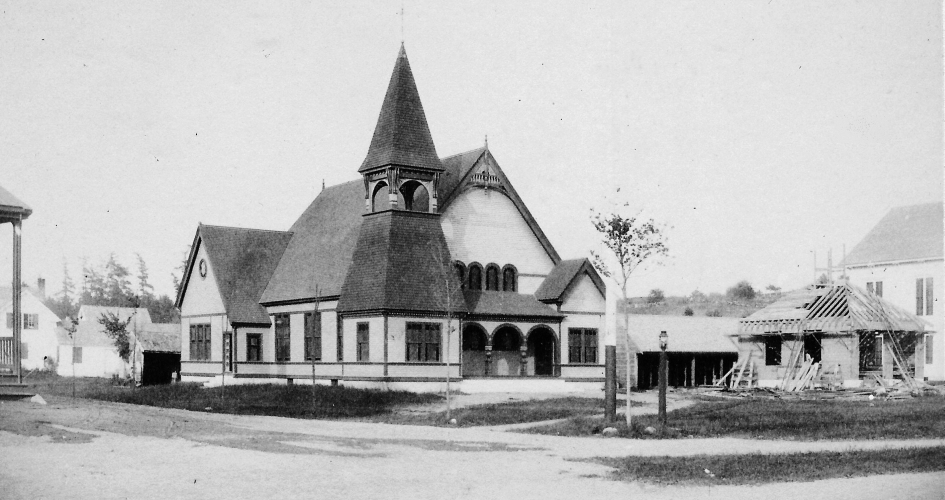
Engine House under construction in 1889, next to the rebuilt Baptist Church and its horse sheds
The 1889 Engine House was built in 26 days. James B. Whipple donated $300 towards the cost of the new firehouse, and $1200 was raised by taxes. The Hadley Brothers provided most of the labor and materials for the project, which was completed just under budget. (James Whipple was the older brother of Joseph Reed Whipple, a wealthy hotelier who owned Valley View Farm. It was J.R. Whipple who rebuilt the general store after the fire, and who made a generous contribution for the reconstruction of the school.) In 1893 James Whipple purchased The Tavern, which had not burned as it was across the river from the fire.
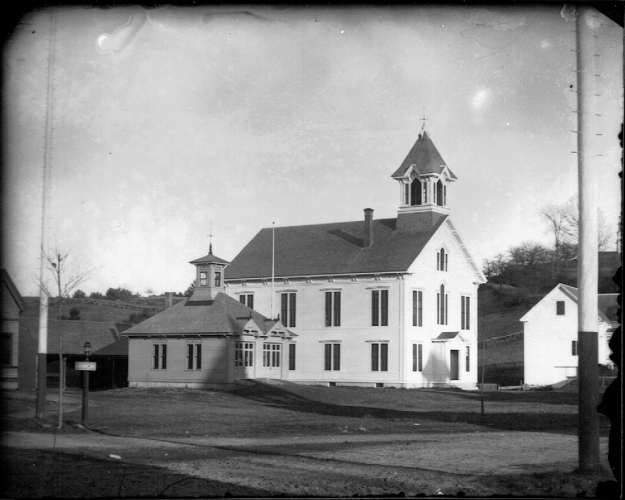
Engine House and Town Hall in 1890, from a glass negative by Myrtle Atwood
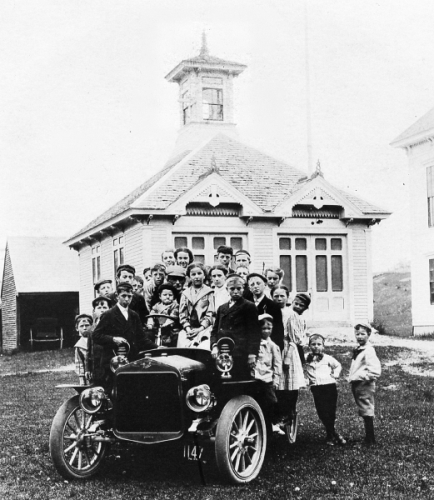 Automobiles were still a novelty when two dozen children swarmed the shiny motorcar in this undated photo.
There's a horse-drawn carriage parked in the shed behind the Engine House.
Automobiles were still a novelty when two dozen children swarmed the shiny motorcar in this undated photo.
There's a horse-drawn carriage parked in the shed behind the Engine House.
The doors of the Engine House faced south at this time. Inside would have been the Constitution #2 fire engine, which is the hand-pumped machine that fought the Fire of 1887 (and lost), and New Boston's famous Molly Stark Cannon, too.
Rena Davis has written that the Engine House was always intended as a home for the cannon, in addition to our town's fire-fighting equipment. The cannon remained here for many years, on or off its oak gun carriage, until it was moved along with the Historical Society museum to the Wason Memorial building in 2010.
New Boston acquired its first motorized fire truck in 1924. Later an addition was made to the Engine House to contain more equipment, and the main doors then faced west towards Dodge's Store, as may be seen in photos below.

You can see what was known as a "telephone booth" at the corner of the firehouse.
Some historians believe that people used to put actual coins into a telephone to make a call!

Postcard from the early 1960s. See how the trees have grown!
 I was inspired to create this page by a photo (right) which I saw in the New Boston Recreation Department newsletter.
It's a view of the Old Engine House which I've never seen: looking up into the hose tower!
Sheri Moloney took the picture of her step-father Everett Whipple, who was re-wiring an old light fixture.
I was inspired to create this page by a photo (right) which I saw in the New Boston Recreation Department newsletter.
It's a view of the Old Engine House which I've never seen: looking up into the hose tower!
Sheri Moloney took the picture of her step-father Everett Whipple, who was re-wiring an old light fixture.
The decorative cupola of the Engine House once served a useful purpose — it's where the fire hoses were hung to dry after use. Pulleys were mounted in the beam you see above Everett's head, and the hoses were hauled up to the wooden pegs still in place to the left of the beam.
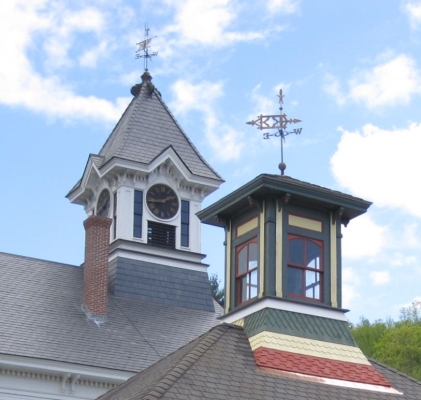 Photo of Everett Whipple in the hose tower courtesy of Sheri Moloney and Mike Sindoni of the New Boston Recreation Department. Thank you, Everett!
Photo of Everett Whipple in the hose tower courtesy of Sheri Moloney and Mike Sindoni of the New Boston Recreation Department. Thank you, Everett!
Historic Colors

Plans for repainting the Old Engine House in 1989, with paint color suggestions
 In 1989, the Old Engine House was 100 years old, and it needed a new roof.
When the crumbling slates were removed, decorative wood shingles were revealed; they had been hidden by a previous repair.
In 1989, the Old Engine House was 100 years old, and it needed a new roof.
When the crumbling slates were removed, decorative wood shingles were revealed; they had been hidden by a previous repair.
The Historical Society petitioned the Selectmen to restore the building to its original appearance, and the Selectmen agreed, except that economical asphalt shingles had to be used in place of slate. Roland Sallada and other volunteers worked with the State of N.H. Architectural Historian. They consulted Moss and Winkler's book of "Victorian Exterior Decoration" and took paint scrapings to determine the original colors, which is why you see today "parchment" siding, "wineberry" windows, and "evergreen" trim.
If you look closely at the wood shingles below the cupola windows, you will see that they are diamond-shaped in the top course (painted "Thunder Bay gray"), scalloped in the middle, and alternating short and long in the bottom course. The lovely gazebo built nearby in 1994 is painted in similar colors.
One other detail for you to notice, while you enjoy a summertime concert on the Town Common or visit the Farmer's Market, is the green-painted fence in front of the Old Engine House. This steel fence with its cast-iron rosettes was once part of the bridge which connected River Road to the railroad depot. After the iron bridge was replaced by a wooden bridge, in recent memory, sections of the bridge fence went to the Old Engine House and also to a footbridge over Lord's Brook on Frog Rock Road.


Fence from the Depot Street bridge is now at the Old Engine House.
